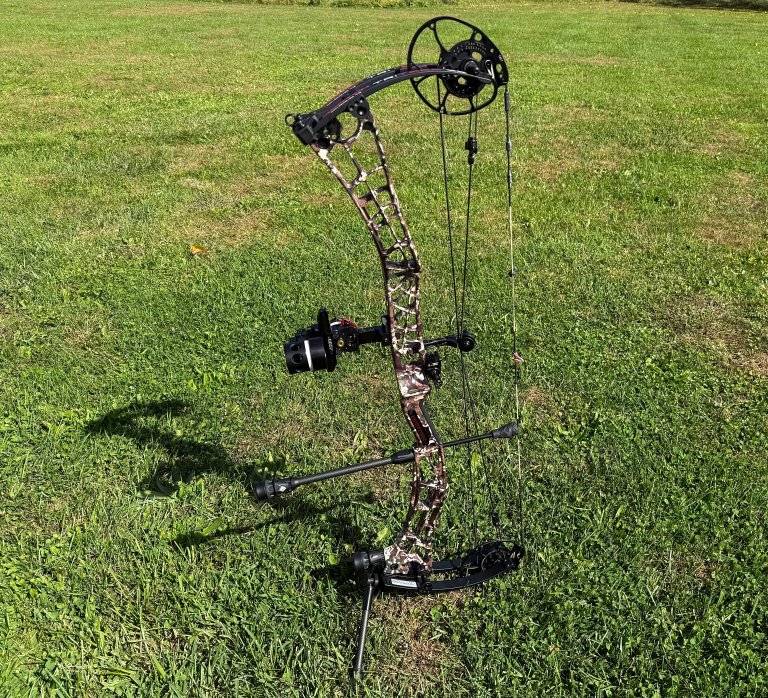The 2025 Darton Archery Sequel ST2 introduced us to two revolutionary tuning features that made it easier to adjust cam lean and timing. Today, Darton launched their new TriTech 35, which adds a third tuning feature — along with some other tweaks — that has to make this one of the most tunable and customizable compound bows I’ve ever seen. Here’s everything you need to know about the Darton TriTech 35 and how it performed on the range.
Darton TriTech 35 Features and Specs
Key Features
-
Axle-to-Axle:
35 inches -
Draw Length:
26 to 31.5 inches -
Peak Draw Weights:
50, 60, 70, and 80 pounds -
Weight:
4.75 pounds -
Speed:
335 fps -
Brace Height:
6.375 inches -
Let-Off:
75 to 83 percent (adjustable) -
Tuning Features:
Micro-adjust roller guard, perfect timing, and perfect tune -
Adjustable grip angle -
Also available in 31 and 33-inch lengths -
1/4-inch draw length adjustment -
Price:
$1,349
Draw Length Adjustment
In the world of making bows fit individuals of all shapes and sizes, 1/4-inch adjustability with a rotating module is the bomb.
Most bows on the market today offer 1/2-inch draw length adjustments. That’s good, but not great. For a lot of people, moving a 1/2-inch up or a 1/2-inch down is too much. They need something in between. And the common way to fix that is to twist the cables on the bow to move to that middle ground.
Well, you need a bow press to do that, for starters. And then, when you twist or untwist cables you affect draw weight and axle-to-axle length in addition to draw length. Engineers have said that can reduce a bow’s efficiency. The TriTech 35 negates all that headache. All you need is Allen wrenches to make 1/4-inch adjustments.
Tuning Features
Perfect Tune

Darton introduced the Perfect Tuning System last year. This system allows you to affect cam lean while tuning your bow without needing a bow press. It involves a single bolt that is moved between the limbs at the limb pocket.
Let’s say you need to lean the cam left to clean up a nock-left paper tear. You’d take the Perfect Tuning bolt and screw it into the receiver on the left limb. How much you drive in the bolt depends on what’s needed to fix the paper tear. If you need right cam lean, move the bolt to the right limb. You can stand on the shooting line, shoot through paper and then make adjustments without leaving the line. Stupid simple.
Improved Perfect Timing System

The second piece of technology that also was introduced last year is the Perfect Timing System. Typically, to adjust the timing of your cams, you have to press the bow and then twist one cable or the other to get the cams in sync. Darton’s Perfect Timing System involves loosening a set screw on a harness attached to each cable. Then you simply twist the cable by hand, without a bow press.
There are two reasons why this system is genius. First, you don’t need a bow press. Second, the adjustability is infinite. When adjusting cam timing on most bows, you’re bound by whole or half twists in the cables because you have to get the cable end loops to fit back onto their posts on the cam. You can’t do a quarter twist, or an eighth of a twist. The end loops won’t be aligned to attach them to the cams.
Darton’s system allows you to put as much – or as little – twist into the cable as you need. And you’d be surprised how often half and whole twists are too much or too little to get the cams in sync. Having infinite adjustability makes life simple. Darton tweaked the Perfect Timing System for 2026 by moving the set screw to a more user-friendly spot, and by adding lines so you can see how much adjustment you’re making when you twist a cable.
Micro-Adjust Roller Guard

The third piece of tech in the TriTech 35 is the new one. And it’s one I’ve never seen before. The Micro-Adjust Roller Guard allows for a second left-right tuning solution with just the turn of an Allen key. You loosen a lock bolt on the roller guard and then turn an Allen key to drive the rollers left or right.
Other bow companies have adjustable roller guards used for tuning, but most of them require you to take the cables off the rollers to relieve the pressure so you can move the guard left or right. With Darton’s, you can make your adjustments without touching the cables. And when you add this tuning system to the Perfect Tuning System, it gives the TriTech 35 double the adjustments in the quest for the perfect bullet hole through paper.

Rounding out the notable features of the TriTech 35 are a Picatinny rail for mounting a sight, a dovetail machined into the riser to allow for mounting an IMS – integrated mounting system – rest, a receiver at the bottom of the riser for mounting a new bipod, and a modular grip that allows for swapping out inserts set at different angles.
Testing the Darton TriTech 35 at the Range
I borrowed a Darton TriTech 35, with a peak draw weight of 70 pounds, from Lancaster Archery Supply. I set the draw length to 30 inches and the draw weight to 70 pounds.
Darton lists the TriTech 35 at 4.75 pounds. I removed the included vibration dampener that attaches to the lower stabilizer bushing and weighed the bow on Lancaster Archery’s shipping scale. It read 4.89 pounds. That’s only a difference of 2.24 ounces, but I wanted to note the difference.
Tuning the Darton TriTech 35
The first step in setting up my bow after adjusting the draw length was to check cam timing. Fortunately, it was out just a bit, which gave me the chance to use the Perfect Timing System. It worked exactly as advertised. I loosened the set screw, gave the cable attached to the bottom cam about ¾ of a twist, which brought that cam into synchronization with the top cam.
Next, it was time to shoot through paper. I got a slight nock-left tear, and so I went straight to the Micro Adjust Roller Guard. I moved the rollers to the left, shot again, and got a perfect bullet hole. Easy.
Speed Testing
As for arrow speed, Darton lists it at 331 fps with the standard module and 335 with the speed module. With my bow set at 30-inch draw length and 70-pound draw weight, I shot a 350-grain arrow over my Garmin chronograph. The standard module produced arrow speeds of 328 fps. When I switched to the speed module, the arrow speed climbed to 335 fps.
So I hit the speed-mod speed rating on the nose. The standard-mod speed I got was 3 fps slower than the rating. That’s pretty close in my book. With a peep sight mounted in the string, that easily could have made up the difference.
Shooting
On the range, the Darton TriTech shot like a dream with the standard module. The speed mod created a draw cycle that’s a bit rough for my liking. The draw with the standard mod was much nicer. It required some effort at the beginning and then the cam rolled over nicely into a deep valley. I used the draw stop that produces 83-percent letoff.
At 35 inches long, the TriTech 35 held solidly on target. I expected that, given the length. A 35-inch bow is big in the bowhunting world. But it’s on the low end of normal for target bows, which are built with aiming accurately as a priority. So no surprise this bow aimed well.
The bow was quiet, with minimal vibration, although it did jump forward at the shot. I like a bow that moves toward the target at the shot, though. And I always hunt with a wrist sling, so I’m not worried about dropping it out of the stand.
As I shot and got used to the bow, I started stacking some solid groups at 50 yards. Then, as a unique challenge, I tacked a standard, shotgun claybird to my archery target and backed up to 80 yards. On my fourth shot, I broke the bird, which measured a hair under 4.5 inches across. And the first two arrows didn’t miss by much. That’s pretty good, considering I’d had less than 2 hours behind this bow at that point.
Final Thoughts
The Darton TriTech 35 is a shooter that’s easy to tune and easy to customize to your specific shooting style. Eastern U.S. whitetail bowhunters might find a 35-inch bow to be a bit big, but there are 33- and 31-inch versions of this bow as well. For the Western hunters, and anyone looking for a dual-purpose bowhunting/target archery rig, this bow is worth a look.
Darton was a household name in the bowhunting world in the 1990s. With the bows they’re producing each year these days, the Darton name is fast returning to prominence.
The post Darton TriTech 35 Review, A New Level of Compound Bow Tuning appeared first on Outdoor Life.
Whitecounty.com Appreciate the great content from Outdoor L:ife









